The Story Behind NASA’s Iconic and Timeless Artemis II Portraits
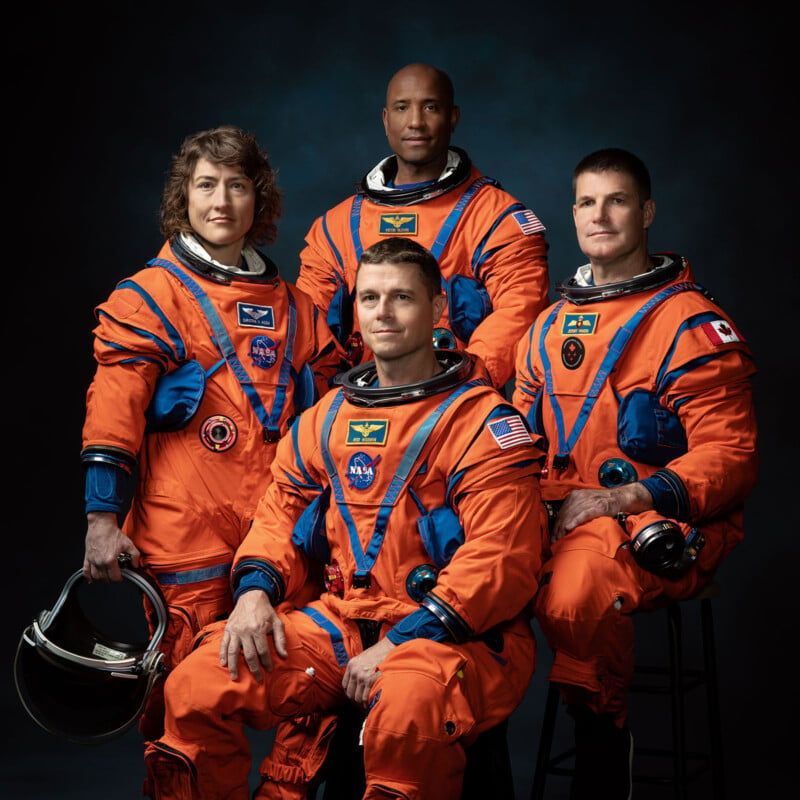
Last week, NASA revealed the four astronauts embarking on the Artemis II mission. It’s a momentous mission for NASA and humanity because Artemis II will be the first time since Apollo 17 in 1972 that a crewed spacecraft will travel to the Moon and beyond low Earth orbit.
For PetaPixel, NASA’s news last week stood out for another reason — the official crew portraits. While it’s easy to be swept up in mission photos from space, which will be available when the Artemis II crew is in space in November 2024, official crew portraits of major space missions also become part of the zeitgeist.
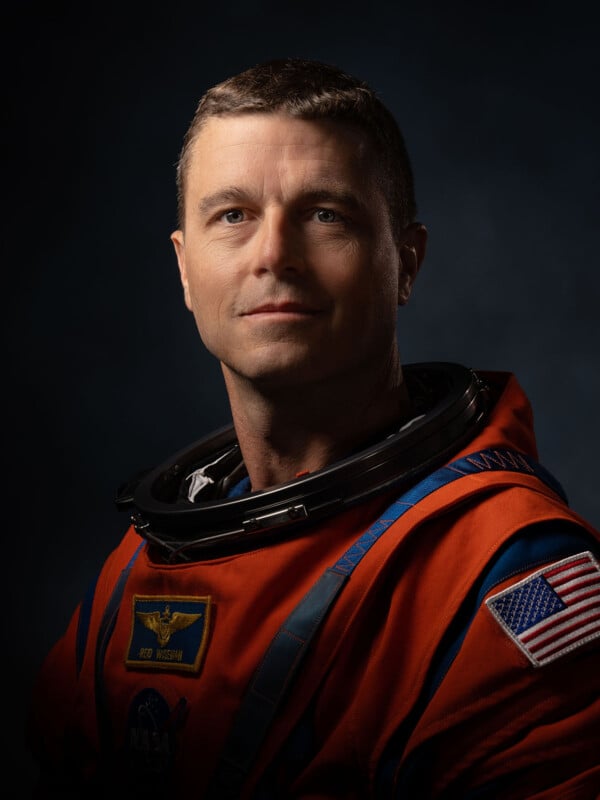
The Artemis II portraits are attention-grabbing because of their dramatic lighting, cinematic feel, and timeless quality. They don’t look like typical NASA portraits or commercial headshots and because of that, PetaPixel wanted to find out the “how” and “why” of the stunning Artemis II portraits.
To get those answers, PetaPixel spoke with the NASA Scientific Photographer behind the incredible Artemis II portraits, Josh Valcarcel, to learn about how his photographic background, what his job at NASA entails, and the story behind his eye-catching Artemis II portraits.
Josh Valcarcel’s Background in the Navy and How the Military Taught Him Photography
Valcarcel is no stranger to working as a creative professional within a government organization; he got his start as a photographer after completing Naval boot camp.
Once he completed basic training, Valcarcel was transferred into a four-month crash course on basic still photography. He learned photography and photographic skills from a technical, structured perspective. He says it was a great environment to learn photography because “it’s nearly impossible to be fired from the military,” so he was free to learn from mistakes behind the camera.
“Looking back, one of the things that helped me the most was starting a creative career in the military,” Valcarcel tells PetaPixel.
View this post on Instagram
“I went to college when I got out, and I saw a lot of young individuals struggle because they were trying to learn a creative art — [photography] is an applied skill, but it is an art.”
In contrast, Valcarcel says, “What the military did for me is tell me this is a creative job, but teach me how they wanted me to do it. This is how the craft is performed. These are the tenets and rules, the prevailing wisdom about how good imagery is captured, and how to work well as a working photographer.”
While at college, Valcarcel saw how challenging it was for photography students without his background to navigate the delicate balancing act of structure versus creativity and technical skills versus artistic skills.
“It can be hard to understand how to bring your creativity into a structured environment, especially when there are stakeholders in the imagery you’re creating. The military gave me that foundation to work from. It taught me how to be a shooter before I needed to worry about who I was as a shooter. I discovered that as I went.”
There are similarities between Valcarcel’s work at NASA and his experience in the Navy.
“There’s a lot of overlap. When I read the job description, it felt familiar to me because of what I’d done in the Navy. I know what it’s like to shoot in the government,” Valcarcel tells PetaPixel.
“I was trained in the Navy about how to photograph award ceremonies, do ‘grip and grin’ portraits, and cover events. I know how to do all of that in the photojournalistic, documentary style the government expects to see. I think NASA has proven to be similar in that regard.”
NASA’s Structured Setting Provides Valcarcel The Best of Both Worlds and Creative Freedom
At NASA, Valcarcel appreciates the attention to detail and emphasis on safety he experienced in the military, but he also benefits from being in a professional civilian environment. He has a structured work environment that allows for more creativity.
“I couldn’t be happier,” says Valcarcel.
Another similarity between his days in the Navy and his work at NASA is that Valcarcel feels a sense of service and duty. His passion for photography was married to his feeling of responsibility and service from the earliest days of his training.
View this post on Instagram
At NASA, he feels that it’s his duty to perform his job a certain way. While every photographer cares about their work, Valcarcel admittedly comes at it from a more duty-bound direction than the typical working photographer.
“I get to relive and expand that same feeling at NASA,” Valcarcel remarks.
Beyond “grip and grin” event portraits and public relations images, his work at NASA also includes many images that are only for internal use, such as photos of engineering and equipment tests. These images, often up close and personal, help NASA engineers and contractors see how their work is progressing and what needs to change as they iterate on equipment.
What Does a Scientific Photographer at NASA Do?
Valcarcel describes himself as like a “campus photographer” at NASA. Whatever is going on that day that requires imagery, that’s something he’d shoot. Sometimes it is press conferences and the aforementioned “grip and grin” portraits for the press, other times it is photographing engineering tests for internal use.
“I serve the scientists and engineers here as a scientific photographer. Many times, that overlaps with needing to get public relations imagery too.”
View this post on Instagram
Sometimes he needs to switch gears quickly from capturing extremely detailed technical images for internal engineering use to photographing images for public affairs that will interest the general viewer outside of NASA.
Speaking of NASA “contractors,” Valcarcel is one of them. While all his work is for NASA, he and the other photographers he works with are employed by Analytical Mechanics Associates (AMA) under the COMIT contract for the space agency.
Teamwork is Paramount at NASA
When speaking to PetaPixel, Valcarcel emphasized the importance of his team. While he captured the fantastic Artemis II portraits that grabbed viewers’ attention, he says that they were only possible because of the support he receives from his supervisor, Mark Sowa, lead photographer Robert Markowitz, and fellow photographers James Blair, Bill Stafford, and Riley McClenaghan.
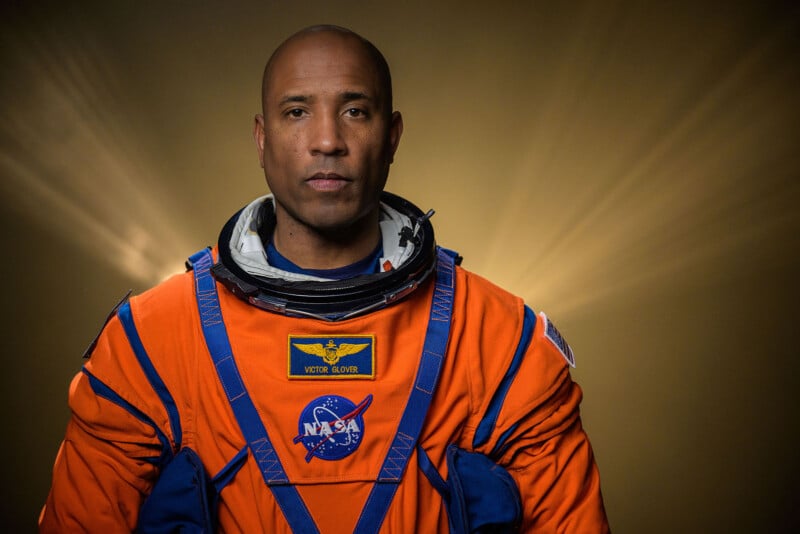
“I took that [crew portrait] and played a part in pitching that concept, but it was a huge team effort. I had to have the support of my supervisor and team. I can’t tell you how many hours we spent as a group working through it. Robert, our lead photographer, was a big instigator in starting the conversation, even last year, about what to do for Artemis II.”
Without the time, space, and support to develop ideas, Valcarcel argues that the result would’ve been much different. He and the team came up with a new vision for Artemis crew portraits that sets the stage for Artemis II and future missions. The portrait concept unifies the past, present, and future in ways Valcarcel expanded upon later in the interview.
Valcarcel’s team not only supports him from a technical, practical perspective but also provides opportunities to flex his creative muscles and push artistic boundaries. While there are certain expectations within NASA as to the required imagery, once Valcarcel “gets the shot,” he often has time to experiment.
View this post on Instagram
NASA’s in-house studio environment is a frequent creative playground, complete with backdrops, lights, and plenty of space.
Valcarcel’s Artemis II Crew Portrait Encapsulates his Background, Career, and the Creative Freedom he has at NASA
“NASA let me approach the Artemis II crew portrait like it was an editorial shoot — with the same level of creativity and freedom. For me, that was a first for something with that kind of visibility and a waiting audience,” Valcarcel says. “I’m very grateful for that.”
“Artemis II is so historically significant to the program and the world at large. NASA trusted me and collaborated with me to produce a crew portrait that we felt would aesthetically be reflective of a new program. We’re moving into the future, and we wanted to represent that aesthetically.”
![]()
“The fact that you’re speaking to me indicates that [the Artemis II crew portraits] are interesting and eye-catching,” Valcarcel says. “To me, that’s super rewarding, because that’s exactly what we wanted to bring for the Artemis program.”
“Working backward from there, I have a lot of opportunities to be creative, and part of that is because I have a lot of support from my supervisor, Mark.”
Valcarcel explains that Mark Sowa tells his team that they should always be able to play at the highest level and strive to match the creative photographic work produced by any commercial photographers in the industry.
“There’s no talk of ‘it’s good enough for government work,'” Valcarcel jokes.
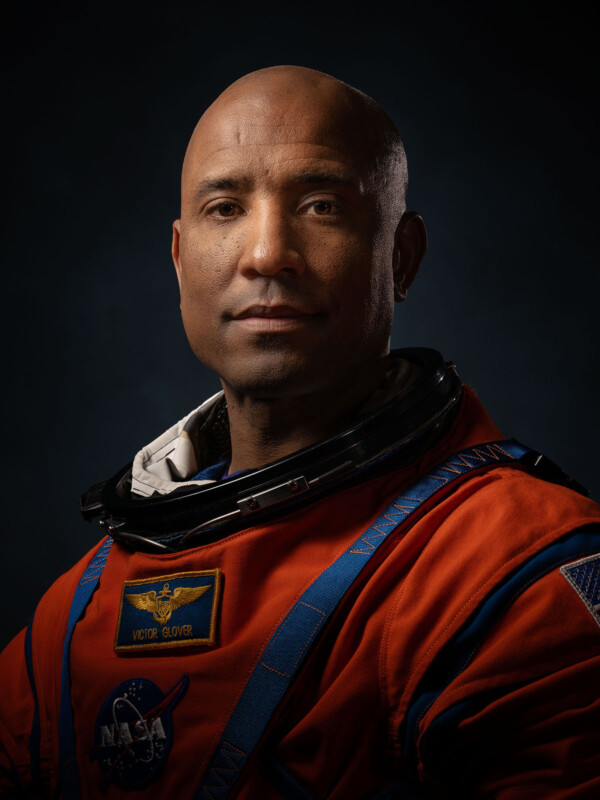
NASA’s Studio Space is Where the Magic Happens
Valcarcel has two hours in the studio for many assignments. During that time, he must capture the expected images. However, with any extra time, he’s able to try new ideas.
As he’s become more proficient with lighting setups and establishing an efficient workflow, his “free” time has continually increased.
“It doesn’t take me two hours to shoot all the official shots now, so I’ve carved out extra time at the end of official shoots. I usually concept an idea, try something in black and white, or do something higher contrast.”
![]()
Part of Valcarcel’s creative process involves working with known constraints. He knows how much time he has and understands the equipment at his disposal. By recognizing limitations, he can focus more energy on ways to be creative given the situation rather than constantly come up against roadblocks he could’ve avoided altogether.
“I build what I think I can do within that constraint. For example, what can I do in 15 minutes to give myself the best odds of getting a different sort of shot that is still usable?” Valcarcel says.
He sets up all his lights ahead of time, even the ones for experimental shots. He uses either different lights altogether or sets up different powers and setups using various wireless channels.
View this post on Instagram
The team stands in for each other to experiment before the official shoots commence, so Valcarcel has lights ready to go when the time comes. It’s just another way in which the team of photographers works together to help each other succeed.
Moments and Emotional Aesthetics
Even when the lights are set up and the shots are meticulously planned, there’s still a bit of luck involved.
“All I have to do is change the radios to a different channel, drop a different color down, maybe change one light, and I’m ready to roll. All I’m trying to do is get a specific look, feeling, or expression. If you don’t get a moment in a portrait, it’s just a picture.”
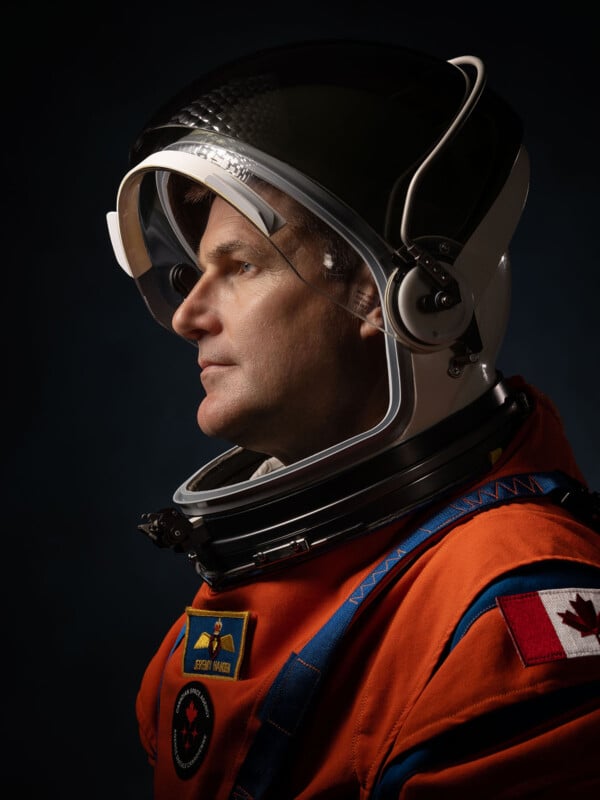
NASA Provides Photographers Exciting Gear
Given NASA’s storied history with Nikon and Hasselblad, it’s likely unsurprising to hear that Valcarcel used Nikon Z9 and Hasselblad X1D 50C II cameras for the Artemis II portraits.
The Z9 is the first mirrorless camera Valcarcel has used, and he’s a big fan of its electronic viewfinder.
“I love mirrorless now. I love the electronic viewfinder and the eye-detect autofocus. The manual focus with the peaking and zooming in enables me to work a lot better as well. Not needing to focus and recompose is amazing.”
The Hasselblad X1D 50C II also proved to be adept for the primary crew portrait. It was the first time Valcarcel had used the camera, as NASA received it just before Artemis II photo day.
![]()
Concerning lighting, the team uses Speedotron lights in the studio. Alongside the lights, photographers like Valcarcel uses grids, octobanks, softboxes, reflectors, barn doors, dishes, and snoots.
Artemis II Portraits Channel the Spirit of Apollo
When asked about his creative vision for the portraits, Valcarcel refers to three historical NASA crew portraits, including the iconic Apollo 11 crew portrait of Neil Armstrong, Michael Collins, and Buzz Aldrin.
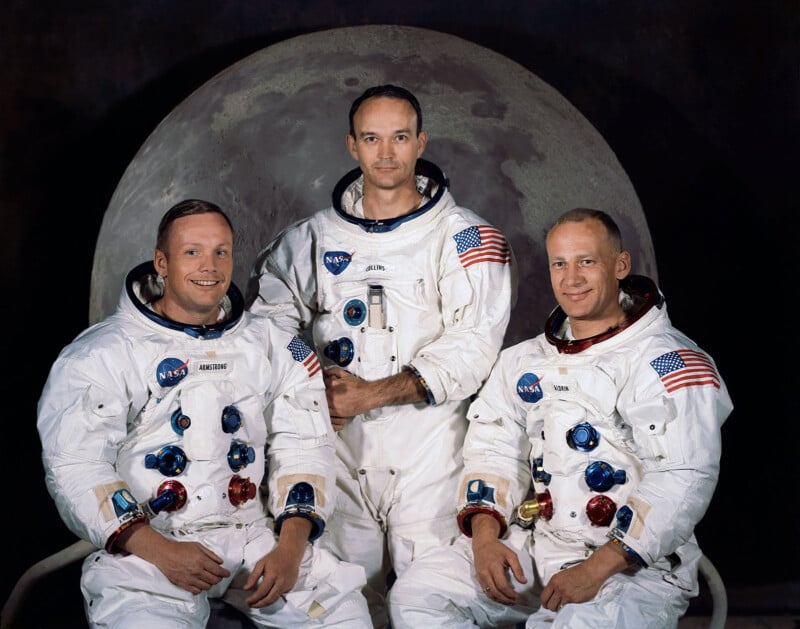
“I’ve wanted to do something like this since I got to NASA almost six years ago. I always wanted to do a different kind of crew portrait, and, amazingly, I got the opportunity to do it with Artemis II.”
The Apollo 11 portrait is an incredible image that informed much of Valcarcel’s concept for Artemis II. “It’s got a lot going for it. It has a modern feel for being shot in the 1960s. It’s got the moon behind it. We know where they’re going and can see them in their suits. But one thing I don’t love about it is that they’re all looking in different directions and have different expressions. There’s a lack of emotional unity. But if you look at Michael Collins, he looks ready to go. I feel like there’s something in his expression. I’m going to reference that look again.”
The other two portraits Valcarcel sent over included a space shuttle crew portrait from the 1990s and an ISS portrait from 2017.
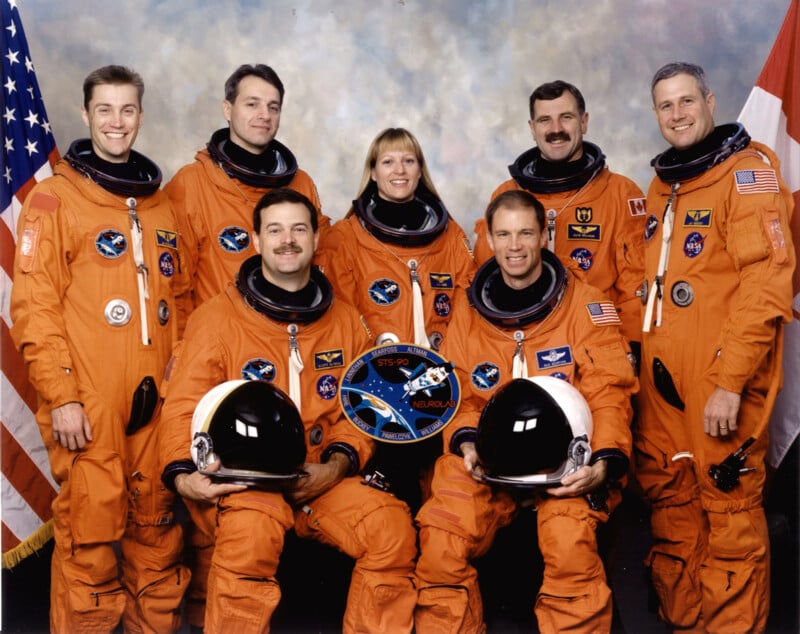
From a design perspective, Valcarcel thinks some of the graphics, especially in the ISS portrait, are distracting and take away from the crew.
“There are a lot of elements that compete for your attention. If we’re going to launch a new program, like Artemis II, I want to go back to focusing on the crew and making the portraits about them.”
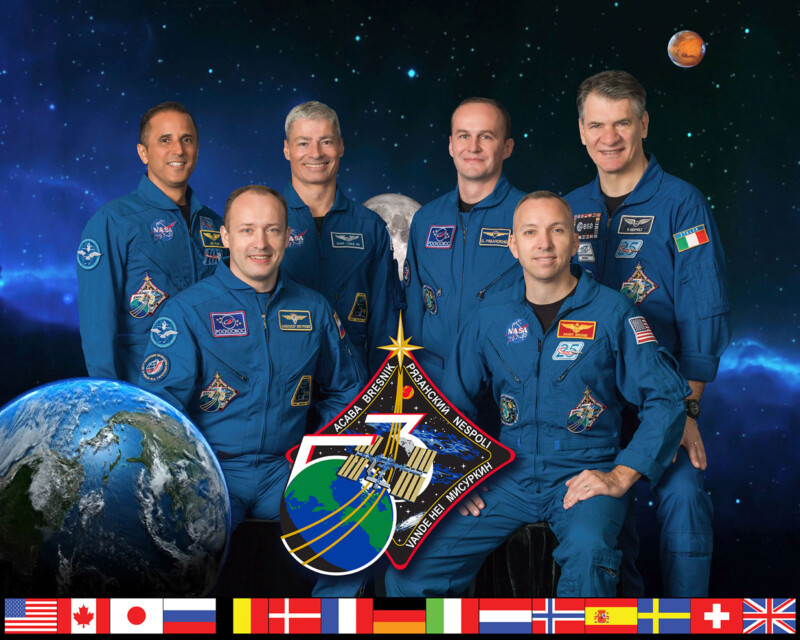
“If you look at the Artemis II portrait, I slimmed it down. I wanted something that fit into the larger narrative of crew portraits over the decades, including the ones I referenced, but modernized for the next generation of going back to the moon.”
There’s a theme of paring things down throughout the Artemis II portraits. Even the Apollo 11 portraits, which have a remarkably modern feel thanks to their simple aesthetic, include a relatively busy background.
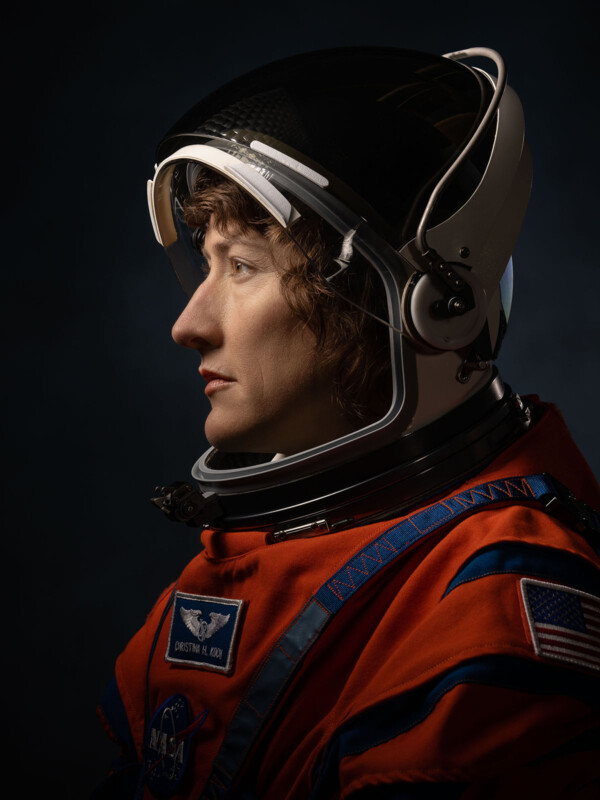
In the Artemis II crew portrait, each astronaut has a unified expression. They have a bit of the “Michael Collins expression” of determination and seriousness but with a bit of a softer edge.
“The overall aesthetic and their expressions lend gravitas to the program. We’re going back to the moon — to stay. The portrait needed to have that impact,” Valcarcel says. He wanted to make a new crew portrait that’s true to its roots but entering the future. The focus needed to be on the crew.
PetaPixel described the portraits as “timeless” to Valcarcel. “I couldn’t be happier that you’d use that word. I wanted to make the portrait stylized without making it at risk of being dated in the future. I wanted this to look and feel like a painting.”
No Detail Too Small
The Artemis II crew portraits were many months in the making, and every aspect of the final photos was discussed and planned far ahead.
An example of this is the backdrop for the Artemis II portraits. The dark, slate-blue background was carefully selected, and Valcarcel had to advocate for the color choice. Alternative options included a background with the moon, lunar surface, or something white or gray.
“It’s a cool, distinct shade of blue,” PetaPixel tells Valcarcel.
“That makes me so happy,” Valcarcel laughs. “There was some internal debate about whether the backdrop should have color. When I was pitching the portraits, I didn’t want them to have the high-key backdrop from the shuttle-era portraits, but I didn’t want it to be a moon in the background either.”
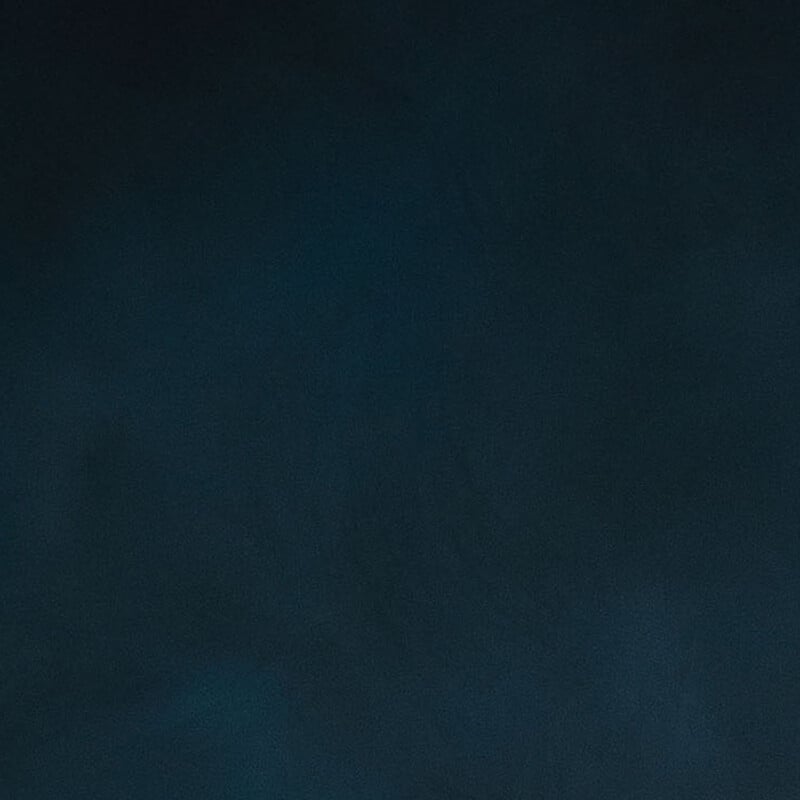
“I really pushed for the background to have a splash of color. I thought that grayscale would be lifeless and lack character. I felt that a touch of color would play well with the orange spacesuits. I worked really hard to get what I thought was a muted blue that would not immediately feel like blue but feels like blue.”
Valcarcel believes that a touch of muted blue conveys the isolated and cold environment of the moon better than a grayscale backdrop could.
“People trusted me with that, and I worked hard to get a good example to send to the artist to hand paint the background.”
The artist did a “phenomenal job,” adds Valcarcel.
The background is an integral part of the portrait, but it’s not something that jumps out at the viewer, which returns to Valcarcel’s primary objective of making the crew portrait about the crew.
“The background is very much a part of the picture, but it’s making you look at the crew.”
Valcarcel’s Lighting Philosophy
Valcarcel tries to achieve as much as possible with few lights.
“That’s not because I don’t think that having more light is bad, but I have a limited capacity of what I can keep track of. I must build sets one light at a time, and for me, it’s easier to keep track when there are fewer lights. Less is more.”
He used just three lights for the crew portrait, which Valcarcel shot with the Hasselblad X1D II 50C and an 80mm lens. The main light is a large gridded octabank, accentuated with a small softbox for fill light. The third light is a small gridded reflector dish with barn doors pointed at the backdrop to give the portrait a splash of color and separate the crew.
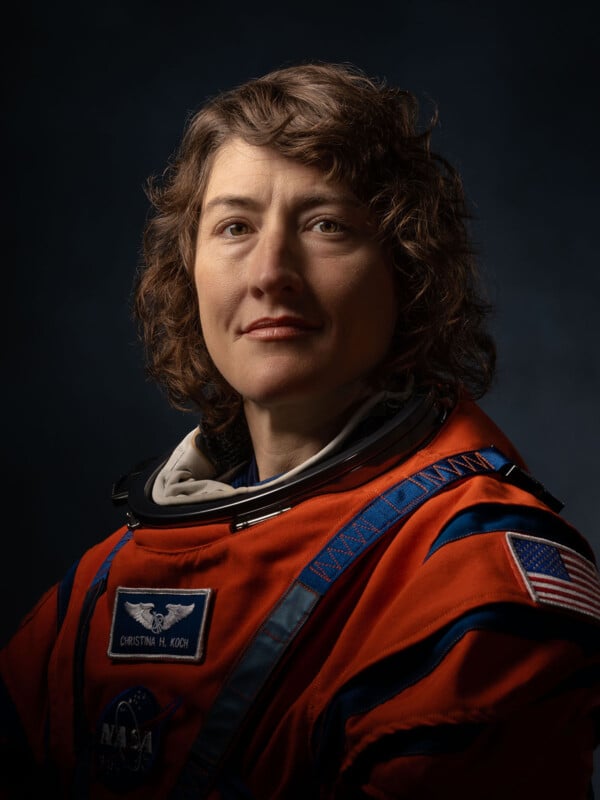
“I want the lights as close to them as possible without it being in the frame. I wanted to have drama and feel but not too much contrast. I spent a lot of time dialing in this fill light.”
He utilized a combination of Rembrandt and loop lighting. If there’s too much contrast for a group portrait, the subjects can look obscured because their faces are smaller in the frame.
The individual portraits include a fourth light, although the general approach is similar, albeit more dramatic. The additional light is a snoot hair light to introduce extra depth.
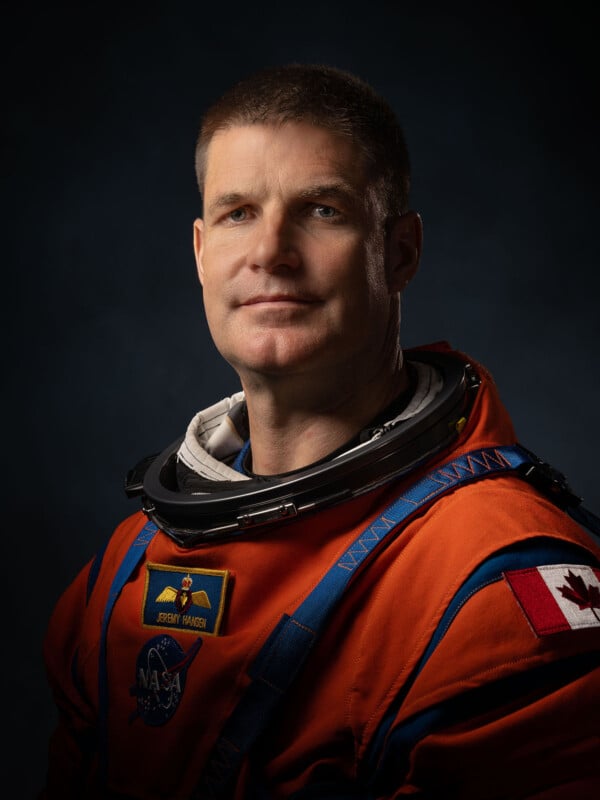
“I’ve done more Rembrandt-style, deeper contrast style portraits before, like with the extra time I have during official shoots. People seem to react positively to those, so for Artemis II, the script is sort of flipped.”
Valcarcel’s “creative alternates” he’s done before, such as the one below, informed the style of the primary Artemis II portraits. It highlights the importance of the creative freedom he’s had during his time with NASA and that the experimental work he’s done before formed the foundation of the official portraits of one of NASA’s most important missions.
View this post on Instagram
Composition
Given Valcarcel’s attention to detail, it’s no surprise that the position of each astronaut in the crew portrait was carefully considered and planned. The composition is simultaneously simple and complex.
For example, NASA astronaut Christina Hammock Koch holding her helmet is an important part of the image. On the one hand, it’s just a helmet, but on the other, it provides critical context without being distracting.
The angle of the other three astronauts, Wiseman, Glover, and Hansen, allow the viewer to see their national flag patches, providing important information about each astronaut without needing to include extraneous graphics like the ISS portrait Valcarcel referenced, which includes extra flags overlaid on the image.
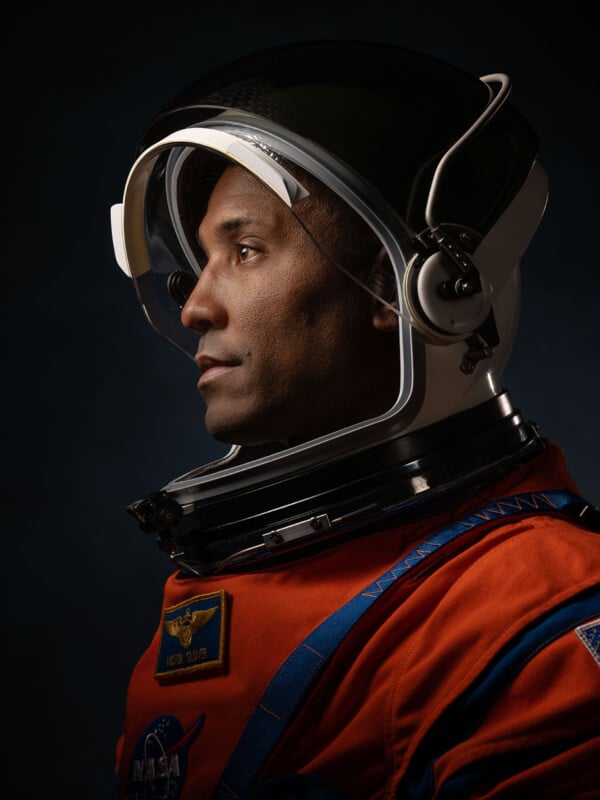
What’s interesting is that while the composition itself was established long in advance, the location of each astronaut was changed during the shoot. Most of the images had the astronauts swapped, but “at the end, we swapped them around, and everyone was in the right spot. Everyone had the right expression.”
“Christina has the perfect expression. She looks regal. Reid looks like an old ship captain, you know? Everyone is vibing really well on that one frame. It’s surprisingly well-balanced, too, I got really lucky. You have to hope for the moment, even when you’re prepared. I got a moment, and that was all driven by them. I tried to get the ‘Michael Collins’ expression’ of looking serious but ‘thinking happy thoughts,’ and I got lucky; they did a great job.”
Connections and History Make Valcarcel’s Job Easier
The astronauts aren’t models. It’s always challenging to photograph people who aren’t necessarily used to being in front of the camera, especially when trying to articulate the body language and facial expression the photographer wants.
Valcarcel has formed a working relationship with people at NASA over a long time. He’s been with these astronauts for years.
“It was really important to know them, especially for this Artemis II portrait. More than a few of them articulated that they trusted me, largely based on imagery I’ve created in the past. I feel like I developed a certain amount of rapport with them and other astronauts over the years. They’re putting good faith in me to deliver on that. This is a really big moment for the program and a huge moment for them as astronauts.”
The Legacy of the Artemis II Portraits
“I’m incredibly honored that the astronauts would collaborate with me and trust me with this. That’s huge. I am so happy and grateful to have been of service and played a part in this.”
The fact that Valcarcel and PetaPixel chatted about the Apollo 11 portrait more than 50 years after it was captured highlights the lasting legacy of iconic missions such as Artemis II.
“You made the images that sort of encapsulate these astronauts’ life work,” PetaPixel tells Valcarcel.
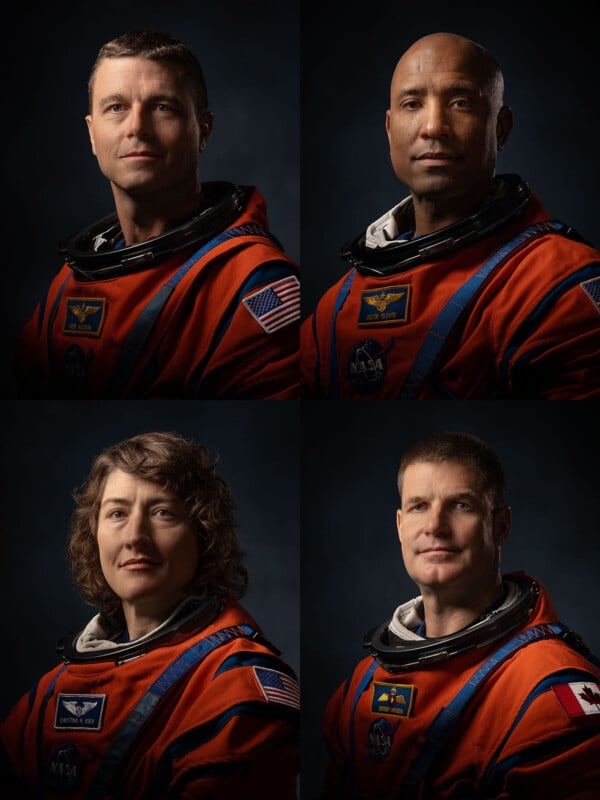
“It’s quite the thing,” Valcarcel says. “For that crew shot specifically, in large part, it introduced these astronauts to the world. Our whole team put a lot of time and effort into making that happen. I’m really glad that it seemed to have all worked out. We all have ideas, and we hope they’re good, but a lot of it goes on good faith and trust in yourself.”
“I’ve always given myself permission to fail confidently. I’ve allowed myself to learn from my mistakes. But this is an instance when you can’t fail. I had to trust myself, all my experience — I had to trust that my sensibilities aren’t nonsensical.”
Valcarcel has always tried to have logic to his creative decisions, but sometimes it’s just a gut feeling, “like having that spike of blue in the background.”
Artemis II is a Culmination of Valcarcel’s Love for NASA and Space
Growing up in Florida, Valcarcel spent a lot of time around space shuttle launches.
“I absolutely love space. I love NASA, I love the astronauts, and I loved it all before I ever thought I’d get to work here. This was an absolute dream come true — over the top amazing to get to do this.”
“I want to produce the best work I can, but that’s almost secondary to wanting to be the best steward of my opportunity. I’m in a position of service to the astronauts, program, NASA, and the world at large.”
Valcarcel emphasizes the impact that older NASA crew portraits had on him and the inspiration they gave him as he grew up and entered his career, even long before he thought he’d ever work for the space agency.
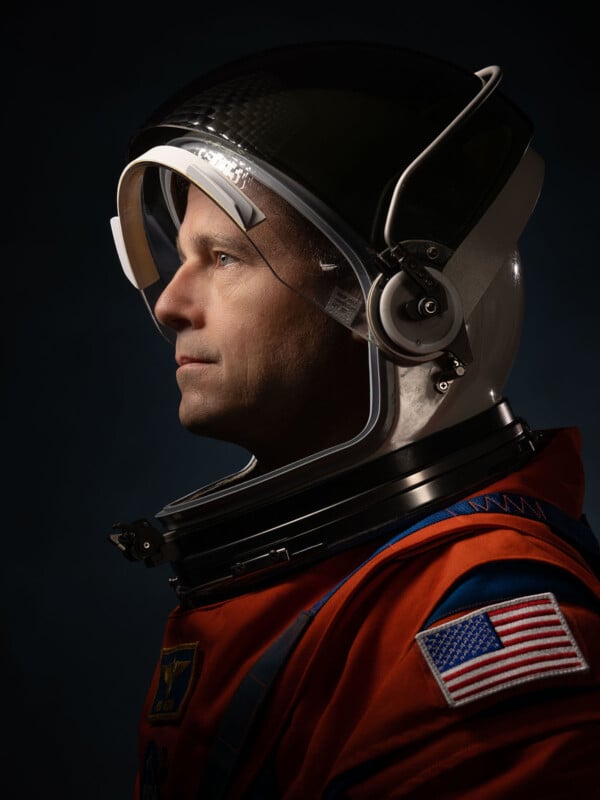
“I want that to be a reciprocal force. I want that inspiration to cycle around. It meant a lot to me that I could maybe do that for other people.
The Artemis II mission is a massive milestone for NASA.
“The historic scale of that and the way it was presented from NASA was, in a weird way, the crew portrait is an image that almost everyone saw. That’s a once-in-a-lifetime thing to create as a photographer, an image that travels that far. It’s amazing to be able to reflect on it.”
View this post on Instagram
“I’m glad I’m reflecting on it now rather than before because that might’ve made me a lot more nervous!” Valcarcel jokes.
Josh Valcarcel and his team worked together for a long time to develop the concept for the Artemis II portraits. It was an extensive effort made possible by a supportive environment full of talented people who trust each other.
The hard work paid off in a big way: The Artemis II crew portraits channel the past and look toward the future in a visually appealing way that’s classic and modern. Valcarcel’s work lays a fantastic foundation for future Artemis missions.
![]()
More of Josh Valcarcel’s work is available on his website and Instagram. There you’ll find some of the “creative alternates” he mentioned that eventually informed the style of the Artemis II portraits.
Image credits: NASA and Josh Valcarcel